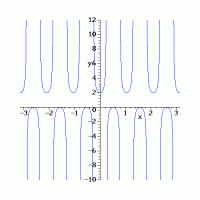You are using an out of date browser. It may not display this or other websites correctly.
You should upgrade or use an alternative browser.
You should upgrade or use an alternative browser.
Please solve this nasty question
- Thread starter chio
- Start date
mmm4444bot
Super Moderator
- Joined
- Oct 6, 2005
- Messages
- 10,902
Please show your attempt. Mistakes may be fixable. Thank you.
Posting Guidelines (Summary)
Welcome to our tutoring boards! :) This page summarizes the main points from our posting guidelines. As our name implies, we provide math help (primarily to students with homework). We do not generally post immediate answers or step-by-step solutions. We don't do your homework. We prefer to...
www.freemathhelp.com
Otis
Elite Member
- Joined
- Apr 22, 2015
- Messages
- 4,414
Hi chio. I'm thinking that four different functions produce such a graph. Did you start with the general transformed cosecant function?
f(x) = a csc(bx + c) + d
If not, then please also share what class you're taking, as well as what has been discussed recently.
?
f(x) = a csc(bx + c) + d
If not, then please also share what class you're taking, as well as what has been discussed recently.
?
Otis
Elite Member
- Joined
- Apr 22, 2015
- Messages
- 4,414
Thus far, we know that |a|=5 and d=1. Therefore, one possible equation is:
y = 5 csc(bx + c) + 1
We're given values for two (x,y) pairs satisfying the equation above. Substituting each yields a system of two equations that solves nicely for b and c.
Hint: First, solve each equation for csc(bx+c), and then consider x-values near zero where csc(x) equals ±1.

y = 5 csc(bx + c) + 1
We're given values for two (x,y) pairs satisfying the equation above. Substituting each yields a system of two equations that solves nicely for b and c.
Hint: First, solve each equation for csc(bx+c), and then consider x-values near zero where csc(x) equals ±1.
Steven G
Elite Member
- Joined
- Dec 30, 2014
- Messages
- 14,396
I would first find the equation of the corresponding sine function, y=Asin(Bx+C)+D.
Recall that a period of sine (and cosine) graph starts when the angle equals 0 and ends when the angle equals 2pi.
The sine graph goes from -4 to 6. (6)-(-4) = 10. The amplitude is A= 10/2 = 5. The graph is therefore raised 1 unit, so D = 1.
It just remains to find B and C.
Think about how to solve for B and C!
Recall that a period of sine (and cosine) graph starts when the angle equals 0 and ends when the angle equals 2pi.
The sine graph goes from -4 to 6. (6)-(-4) = 10. The amplitude is A= 10/2 = 5. The graph is therefore raised 1 unit, so D = 1.
It just remains to find B and C.
Think about how to solve for B and C!


